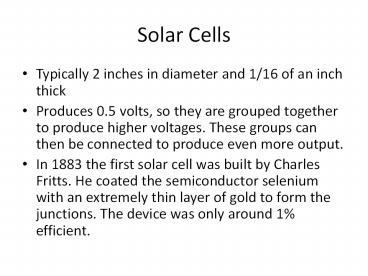Solar Cells - PowerPoint PPT Presentation
Title:
Solar Cells
Description:
Solar Cells Typically 2 inches in diameter and 1/16 of an inch thick Produces 0.5 volts, so they are grouped together to produce higher voltages. – PowerPoint PPT presentation
Number of Views:312
Avg rating:3.0/5.0
Title: Solar Cells
1
Solar Cells
- Typically 2 inches in diameter and 1/16 of an
inch thick - Produces 0.5 volts, so they are grouped together
to produce higher voltages. These groups can then
be connected to produce even more output. - In 1883 the first solar cell was built by Charles
Fritts. He coated the semiconductor selenium with
an extremely thin layer of gold to form the
junctions. The device was only around 1
efficient.
2
Generations of Solar cells
- First generation
- large-area, high quality and single junction
devices. - involve high energy and labor inputs which
prevent any significant progress in reducing
production costs. - They are approaching the theoretical limiting
efficiency of 33 - achieve cost parity with fossil fuel energy
generation after a payback period of 5-7 years. - Cost is not likely to get lower than 1/W.
3
Generations of Solar cells
- Second generation-Thin Film Cells
- made by depositing one or more thin layers (thin
film) of photovoltaic material on a substrate. - thickness range of such a layer varies from a few
nanometers to tens of micrometers. - Involve different methods of deposition
- Chemical Vapor deposition the wafer (substrate)
is exposed to one or more volatile precursors,
which react and/or decompose on the substrate
surface to produce the desired deposit.
Frequently, volatile by-products are also
produced, which are removed by gas flow through
the reaction chamber.
4
Thin Film deposition techniques
- Electroplating
- electrical current is used to reduce cations
(positively charged ions) of a desired material
from a solution and coat a conductive object with
a thin layer of the material. - Ultrasonic nozzle
- spray nozzle that utilizes a high (20 kHz to 50
kHz) frequency vibration to produce a narrow drop
size distribution and low velocity spray over the
wafer - These cells are low cost, but also low efficiency
5
The Third Generation
- Also called advanced thin-film photovoltaic cell
- range of novel alternatives to "first generation
and "second generation cells. - more advanced version of the thin-film cell.
6
Third generation alternatives
- non-semiconductor technologies (including polymer
cells and biomimetics) - quantum dot technologies
- also known as nanocrystals, are a special class
semiconductors. which are crystals composed of
specific periodic table groups. Size is small,
ranging from 2-10 nanometers (10-50 atoms) in
diameter. - tandem/multi-junction cells
- multijunction device is a stack of individual
single-junction cells - hot-carrier cells
- Reduce energy losses from the absorption of
photons in the lattice - upconversion and downconversion technologies
- Put a substance in front of the cell that
converts low energy photons to higher energy ones
or higher energy photons to lower energy ones
that the solar cells can convert to electricity. - solar thermal technologies, such as
thermophotonics(TPX) - A TPX system consists of a light-emitting diode
(LED) (though other types of emitters are
conceivable), a photovoltaic (PV) cell, an
optical coupling between the two, and an
electronic control circuit. The LED is heated to
a temperature higher than the PV temperature by
an external heat source. If power is applied to
the LED, , an increased number of electron-hole
pairs (EHPs) are created.These EHPs can then
recombine radiatively so that the LED emits light
at a rate higher than the thermal radiation rate
("superthermal" emission). This light is then
delivered to the cooler PV cell over the optical
coupling and converted to electricity.
7
(No Transcript)
8
Efficiency and cost factors
- In 2002 average cost per peak watt was
2.90-4.00. Coal fired plant is 1.00/watt. - Efficiency is not great.
- Recall, 77 of the incident sunlight can be used
by the cell. - 43 goes into heating the crystal.
- Remaining efficiency is temperature dependent
- Average efficiency of a silicon solar cell is
14-17 - The second and third generation technologies
discussed are designed to increase these
efficiency numbers and reduce manufacturing costs
9
Novel approaches
- UA astronomer Roger Angel
- Uses cheap mirrors to focus sunlight on 3rd
generation solar cells (triple junction cells)
which handle concentrated light - 1.00 per watt achievable-competitive with coal
plants - Potential 1 solar farm 100 miles on a side could
provide electricity to the whole nation - Does not have to be all in one place
10
Solar Cooling
- Consider a refrigeration system with no moving
parts. - Heat the coolant (say ammonia gas dissolved in
water) and force it via a generator into an
evaporator chamber where it expands into a gas
and cools. Move it to a condenser and cool it
back to a liquid and repeat the process. - These systems actually have existed for a number
of years, refrigerators in the 1950s were sold
with this technology (gas powered and there
was/is a danger of CO emissions). - Energy to heat the coolant and drive it through
the system comes from burning fuel or a solar
cell to provide electricity to do the heating. - Need what is called a concentrating collector
(lens or other system to concentrate more light
on the solar cell). - Ideally, you could do this with a flat plate
collector system, though you do not obtain as
much cooling. - Devices are not widely used, due to the
intermittency of sunlight
11
(No Transcript)

